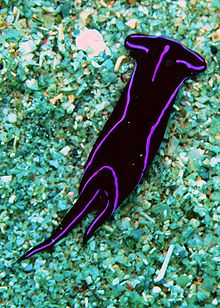| Chelidonura | |
|---|---|
 | |
| Chelidonura varians | |
| Scientific classification | |
| Domain: | Eukaryota |
| Kingdom: | Animalia |
| Phylum: | Mollusca |
| Class: | Gastropoda |
| Subterclass: | Tectipleura |
| Order: | Cephalaspidea |
| Family: | Aglajidae |
| Genus: | Chelidonura A. Adams, 1850 |
| Type species | |
| Bulla hirundinina Quoy & Gaimard, 1833 | |
| Species | |
See text | |
Chelidonura is a genus of small, sometimes colorful, sea slugs. These are headshield slugs or cephalaspideans, marine opisthobranch gastropod mollusks in the family Aglajidae. [1]
Contents
The two rather long "tails" at the end of the animal are characteristic of the genus.